#A ROMAN BRONZE SPHINX
Explore tagged Tumblr posts
Text
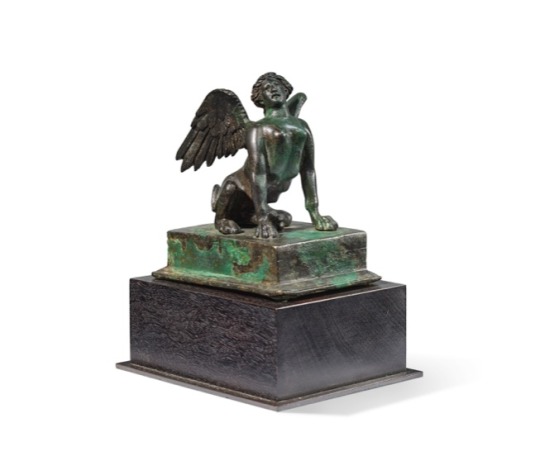
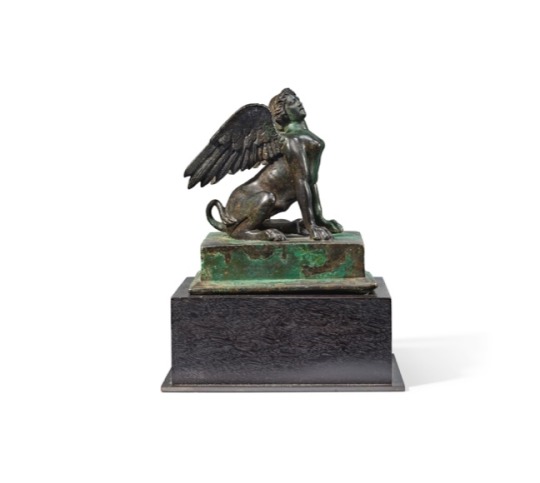
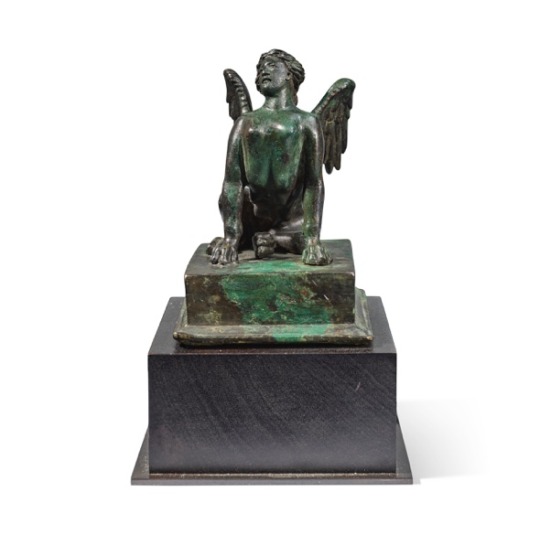
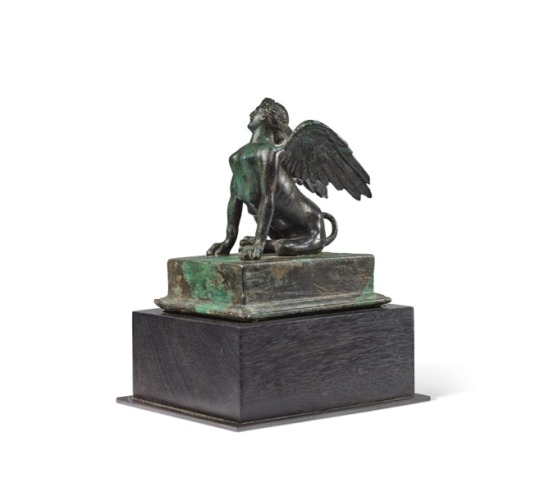

A ROMAN BRONZE SPHINX CIRCA 1ST CENTURY B.C. - 1ST CENTURY A.D.
Representations of sphinxes are known in Egyptian, Greek and Roman art, from the Great Sphinx in Giza dating the 4th Dynasty to diminutive 3rd Century Roman intaglios: it was a popular subject matter. Originally the sphinx was an Egyptian invention - the term comes from the Egyptian shepesankh or 'living statue', combining a human head with the body of a lion. In Egyptian times they were seen as protectors of temples and sanctuaries or as an image of royalty with the face of the Pharaoh. This Roman bronze however, is a more sensuous winged representation, seated and pushing back on her front legs with her body raised and head thrown back, her breasts are visible and her ribcage beneath. The details of her hair and wings are finely incised.
The dating of this bronze sphinx suggests that she would have been made during the rule of Augustus, whose seal ring, that he had inherited from his adoptive father, Julius Ceasar, depicted a sphinx. Augustus also employed the device of a seated sphinx on some of his coins minted circa 20 B.C.
#A ROMAN BRONZE SPHINX#CIRCA 1ST CENTURY B.C. - 1ST CENTURY A.D.#bronze#bronze statue#bronze sculpture#ancient artifacts#archeology#archeolgst#history#history news#ancient history#ancient culture#ancient civilizations#ancient rome#roman history#roman empire#roman art
77 notes
·
View notes
Text
🦉Athena Masterpost🦉
This masterpost will cover very basic information with links to further posts or resources (otherwise it’s super long) and may be updated in future with extra sections. Basic bibliography at the end. I welcome you to share your UPG and resources in the comments - I won’t differentiate between mine and others’ UPG.
UPG = Unverified Personal Gnosis, SPG = Shared Personal Gnosis, H = Historically Inspired association
Last updated: 5 Feb 2025, added my ko-fi
Love this post? Consider thanking me with a small donation to my ko-fi!

Overview
Athena is the Hellenic goddess associated most commonly with wisdom, war, weaving, and in modern times, education and knowledge. She was a goddess who occupied both masculine and feminine roles in a highly patriarchal society, standing outside the societal binary. She is a fascinatingly variable and nuanced deity who has adapted and persisted in the mind of western society until this day. This masterpost is in dedication to her.
“Through our investigation of [Athena’s] role within the pantheon, she has emerged as a power of technology and creativity who promotes creativity and order, but with another side to her power, that of the storm bringer and warmonger.” -Susan Deacy
Athena, Goddess of…
Metis (Cunning)
Skill
Crafts
Invention
War
Civilization
Hero Mentorship
Education and Knowledge [SPG]
🐍Find out More!🐍

Symbols, Colors & Tarot Cards
Traditional: Owls (Specifically the Little Owl, Athene noctua), Snakes, Horses, Gulls, Crows (In Messenia and Boeotia, though elsewhere she was not fond of them), Olive trees, the Aegis, the Gorgoneion, Spindle, Spear, Helmet (Particularly with gryphons and/or sphinxes on it).
Other symbols: Spiders [Roman & SPG], Books and Scrolls [SPG], Pens or Quills [UPG]
Colors: Saffron/Yellow/Orange/Gold [H], Murex Purple [H], Hyacinth Blue [H], Red [H?], Bronze [H], Green [UPG]
🐍Find out More!🐍
Tarot Cards (All UPG/SPG of course): The Emperor, The Hierophant, The Chariot, Strength, Justice, The World, Knight of Pentacles, Queen & King of Swords, Queen & King of Wands

Name & Epithets:
Athena has some variations in name. The Attic form was “Athenaia”, which was contracted to “Athena,” the Ionian form was “Athenaie,” the Doric form “Athana,” in Aeolic, “Athanaa,” and in epic she was “Athenaie,” shortened to “Athene.”
A few common epithets:
Areia - Warlike
Ergane - The Worker
Glaukôpis - Bright/owl-eyed.
Pallas - Refers either to the myth of Athena’s childhood friend Pallas, or of the giant named Pallas whom she slayed.
Parthenos - Maiden
Polias - Of the City
Polymetis - Cunning in many ways
🐍Find out More!🐍

Offerings and Devotional Acts
This section was super long! Only including a few here but check out the link!
Gemstones & Metals - Gold, Lapis Lazuli, Onyx, Iolite
Plants - Olive, Ivy, Thyme, Rosemary, Cypress, Peppermint, Orange
Incense and Fragrances - Frankincense, Thyme, Bay Laurel, Amber, Myrrh, Dragon’s Blood, Orange, Citrus, Cedarwood, Cinnamon, Cypress, Bergamot & Sage
Food & Drink - Olives and Olive Oil, Honey, Milk, Cheese, Cereal Grains, Diluted Wine, Bread, Baked Goods, Fish, Meat, Fruit/Fruit Juice, Water
🐍Find out More!🐍

Athenian Festivals
Athena’s main festivals were the Panathenaia, Khalkeia, Kallynteria and Plynteria. It is up to individuals to decide if and how to include these celebrations in their practice.
Panathenaia: The biggest festival for Athena taking place annually, but with a bigger version every fourth year. Mainly a festival with athletic, poetry and musical competitions.
Kallynteria and Plynteria: Sacred days centered around cleaning.
Arrephoria: A mysterious festival that took place at night and is theorized to have been a fertility rite.
Khalkeia: The festival of artisans, which celebrated Athena and Hephaestus.
🐍Find out More!🐍

Family & Connections
Parents: Athena’s father was Zeus (Except in Libya, where she was known as Poseidon’s daughter) and her mother was the personification of wisdom, Metis. In some sources she was raised by Triton alongside his daughter, Pallas.
Children: Athena had no children as a virgin goddess but she did adopt and raise Erichthonius, who later became king of Athens.
Retinue: Athena was often associated closely with Nike (Victory), an example being the famed statue Athena Parthenos, which held Nike in its hand. The aegis which Athena wore also contained the personifications Phobos (Fear), Eris (Strife), Alke (Strength) and Ikoe (Panic) as noted in the Iliad.
Companions: Pallas is perhaps the most famous of Athene’s companions, as the two girls grew up together until Athena accidentally killed Pallas and afterwards took on her name as an epithet. However, in the Homeric Hymn 2 to Demeter it is shown that Athena, Artemis and Persephone spent time together and were playing and collecting flowers before Persephone was abducted. The Greek historian Diodorus Siculus claims they were also raised together.
Heroes: Athena was a mentor of Heroes and had a hand in assisting heroes such as Herakles, Odysseus and Diomedes, but also Achilles, Bellerophon, Perseus, Theseus, Kadmos and Tydeus.

🐍More of my Info Posts!🐍
Athena and Childbirth
Athena Hippia / Khalinitis
On The Nature of Metis - Excerpts from “Cunning Intelligence in Greek Culture and Society”
On the comparison of Athena and Ares
Athena and Herakles: Excerpt from Susan Deacy’s book
Myth of Athena's Birth

🐍Extra Links🐍
Prayers, Hymns and Poems
Homeric Hymn to Athena 11 [Tumblr - Mine]
Homeric Hymn to Athena 28 [Tumblr - Mine]
Poem for Athena [Tumblr - Mine]
Adaptation of the Orphic Hymn [Tumblr - wisdomweaver]
Ode to Athena: A Birth of Wisdom [Tumblr - panjackdaw]
Prayer to Athena [Tumblr - rue-with-the-tarot]
Hymn to Athena [Tumblr - entricacies]
Praise to Athena [Tumblr - piristephes]
Prayer for Clarity and Sound Intuition [Tumblr - crimsonsongbird]
Prayer for Athena [Tumblr - hisfleur]
Prayer for Athena [Tumblr - evilios]
Prayer to Athena [Tumblr - ranger5000]
Chin Up - A Message From Athena [Tumblr - crimsonsongbird]
Assortment of Prayers [Website - greekpagan.com]
Battle Armor Poem [Tumblr - crimsonsongbird]
A Prayer to the Wise Short Poem [Tumblr - crimsonsongbird]
Learning Short Poem [Tumblr - Mine]
Additional Links
Theoi.com [Website]
Iliad - Athena dons the Aegis [Tumblr - Mine]
Reconstruction of Athena Parthenos statue’s colors [Youtube - Museum of Fine Arts, Boston]
Bathing of Athena in Argos [Tumblr - verdantlyviolet]
Subtle Athena Worship [Tumblr - khaire-traveler]
A response to the “Athena is a victim blamer and hates women” crowd [Tumblr - rightwheretheyleftme]
khaire-traveler on their snow leopard UPG [Tumblr]
Parthenon 3D Reconstruction [Youtube - Ancient Athens 3D]
Parthenon in AC: Odyssey [Youtube - Invicta]

Bibliography
Barber, E.J.W. - The peplos of Athena
Burkert, Walter - Greek Religion
Deacy, Susan - Athena
Deacy, Susan & Villing, Alexandra - Athena in the Classical World
Deacy, Susan & Villing, Alexandra - What was the colour of Athena's Aegis?
Detienne, Marcel & Vernant, Jean-Pierre - Cunning Intelligence in Greek Culture and Society
Drees, Ludwig - Olympia
Larson, Jennifer - Ancient Greek Cults
Mansfield, John Magruder - The Robe Of Athena And The Panathenaic "Peplos"
Maurizio, Lisa - Classical Mythology in Context
Mikalson, Jon D. - Ancient Greek Religion
Ogden, Daniel - A Companion to Greek Religion
Theoi.com

#Athena Masterpost#Athena#Athena Deity#Athena Goddess#Athena Worship#Helpol#hellenic polytheism#hellenic polytheist#hellenic paganism#paganblr#hellenic pagan#paganism#athena devotion
46 notes
·
View notes
Text
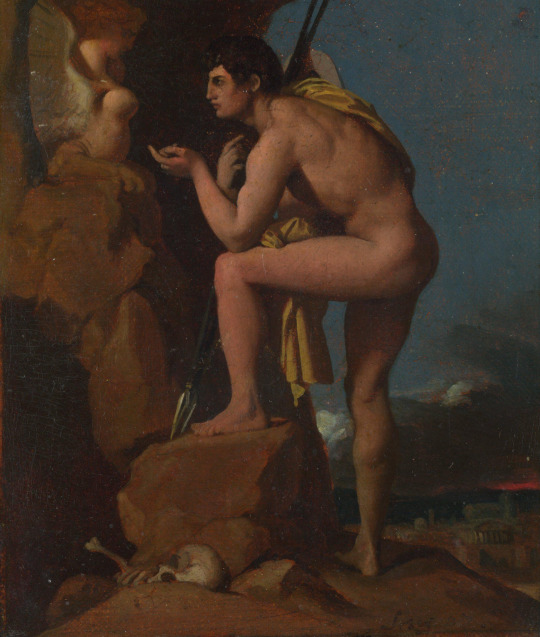
Jean Auguste Dominique Ingres (French, 1780 - 1867) Oedipus and the Sphinx, 1808 National Gallery, London Oedipus, a figure from Greek mythology, stands nude and in profile before the Sphinx, who guards the entrance to the ancient city of Thebes. The Sphinx – a monster with the face, head and shoulders of a woman, a lion’s body, and bird’s wings – asks Oedipus to solve the riddle she poses to all travellers seeking to enter the city: ‘What has a voice and walks on all fours in the morning, on two at noon, and on three in the evening?’ Oedipus correctly answers that it is man who crawls on all fours as a child, walks on two legs as an adult, and uses a walking stick as a third leg in old age. The bones of a previous traveller, killed by the Sphinx for having failed to solve the riddle, lie at the bottom of the picture. Thebes is visible in the distance on the right.
The theme of a monster defeated by human intelligence clearly appealed to Ingres. The picture also complements another of his paintings, Angelica saved by Ruggierro, which shows a chivalrous knight attacking a sea monster to save a princess. But this is also a painting of a man facing his destiny, as Oedipus’s actions will lead him to become King of Thebes, as the oracle predicted at his birth, and to unknowingly marry his own mother, Jocasta. This unwitting tragedy and its consequences is the drama of Oedipus Rex, the middle play of Sophocles' Theban Plays.
This painting is a later, and smaller, version of one painted in 1808 and subsequently reworked in 1827 (Louvre, Paris). The first version of Oedipus and the Sphinx was essentially a figure study that Ingres painted while studying at the French Academy in Rome. It was sent to Paris to be judged by members of the Institut de France. As required by the Institut’s rules, the figure of Oedipus was based upon a live model, although the pose was derived from the classical statue, Hermes Fastening his Sandal (Louvre), a Roman marble copy of a lost Greek bronze. Oedipus’s body is presented as an arrangement of geometrical shapes; for example, the triangle formed by his left arm, thigh and chest is mirrored and inverted by his left upper arm and forearm. The use of profile for both Oedipus and the Sphinx, together with the shallow space in much of the picture, recalls classical friezes and ancient Greek vases, which Ingres used as the sources for his deliberately classical artistic style.
#Jean Auguste Dominique Ingres#French art#mediterranean#art#fine arts#1800s#fine art#european art#classical art#europe#european#oil painting#europa#mythology#mythological art#classical#Oedipus and the Sphinx#1808#painting#artwork
118 notes
·
View notes
Text
Egyptian Gods on Christian Era Roman Coins
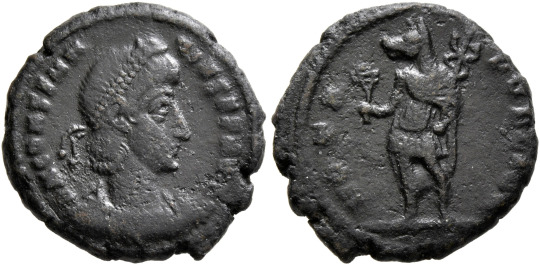
Constantius II, festival of Isis issue, struck 352-355 Obverse depicts diademed bust of Constantius facing right. Reverse depicts Anubis, standing left, holding caduceus and sistrum.
The festival of Isis coins are some of the most fascinating pieces struck by Rome in my opinion, especially when taking into consideration that these coins depicting Egyptian deities were still struck under notoriously Christian emperors.

Festival of Isis bronze, 4th century Obverse depicts bust of Isis facing right, wearing hem-hem crown. Reverse depicts Harpocrates standing left and holding a cornucopia
The festival itself was held to commemorate the arrival of the ship of Isis that departed from Alexandria and arrived in Rome on March 5th. The last known emperor depicted on a festival of Isis issue is Valentinian II, and the festival would stop being held in the city of Rome around 416.
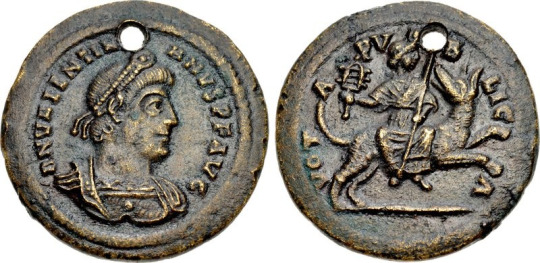
Festival of Isis medallion, Valentinian I, 364-375 Obverse depicts diademed bust of Valentinian I facing right. Reverse depicts Isis, holding sistrum and scepter, riding on Sothis.

Crispus, Festival of Isis issue, 316-326 Obverse depicts bust of Crispus facing right. Reverse depicts Isis Pharia on galley, standing to left, head facing right, holding sistrum.

Festival of Isis bronze, 4th century. Obverse depicts bust of Sol-Serapis facing right. Reverse depicts winged sphinx advancing right.
9 notes
·
View notes
Text
The Ministry of Tourism announces the artifacts that were chosen to be the featured pieces in December in antiquities museums across the country

The Ministry of Tourism conducted a public referendum through its pages on the social networking site Facebook, and the public chose this month a group of artifacts that highlight Egyptian civilization's interest in science, knowledge, and culture in celebration of Science Day, which falls on December 21 of each year. This date also coincides with the opening of Cairo University on the same day in 1908.
The most famous places chosen are the Museum of Islamic Art in Bab Al-Khalq and the Coptic Museum in Old Cairo because it displays a wooden board used to teach writing, carved on it numbers and writings in the ancient Coptic language. The choice also fell on the Al-Gaar Anderson Museum, which contains a metal ink container shaped like a fish. The Muhammad Ali Museum is also one of the most famous sites that were dedicated to spreading science in Egypt, and this museum displays three of the oldest inkwells in Egypt. You can also explore the Amhotep Museum in Saqqara, which displays a statue of the scribe Ptah Shepses, who held several titles, the most famous of which were judge and inspector of the god's priests.
If your flight arrives at Cairo International Airport, you should see the bronze statue of the god of wisdom, medicine, and writing, Thoth. If you are going to visit Alexandria, you should not miss visiting the Alexandria National Museum, which displays the First Class Order of Education. You can also visit the Greco-Roman Museum, which contains a marble statue depicting an intellectual wearing the Greek cloak "himation," which is a symbol of culture. You can visit all these places and more only with Egypt Tours, which will allow you to choose from many exciting tours.
If your ship will stop for some time in any of the Egyptian ports, choose one of Egypt Cruise Excursions, which is a priceless gift for any tourist visiting Egypt for the first time. You can find many tours available that are ideal options for exploring Egypt, such as Port Said Shore Excursions, which will enable you to visit all the famous archaeological sites. Sokhna Port receives millions of tourists every year, so we have organized many excursions from Sokhna Port so that you can choose the tour that suits your interests.
If your ship will only stop for a few hours in the port, you can book a half-day tour to Saqqara and the Dahshour Pyramids from Sokhna to enjoy a wonderful trip in a short time. Egypt is one of the most famous countries that has many amazing museums, so you should join the NMEC and Pyramids Tour from Sokhna Port, which will help you visit one of the most important and impressive museums in Egypt, which is the National Museum of Egyptian Civilization. You can visit many amazing archaeological sites in one tour if you book a Day tour to the Pyramids, Memphis, and Saqqara from Sokhna Port, which is one of the best-selling tours.
You can book Pyramids and Saqqara Desert Tours from Sokhna Port to enjoy exploring the Giza Pyramids and Saqqara area while riding four-wheel-drive bikes. If you are a fan of visiting amazing museums, just join our day tour to the museums in Cairo from Sokhna port to be able to visit the National Museum of Egyptian Civilization and Abdeen Palace. You can take your friends and family on an unforgettable trip by booking the Giza Pyramids and the Step Pyramid tour from Sokhna Port and taking many beautiful souvenir photos with the Giza Pyramids.
You can choose between watching the sunrise or sunset in the pyramids area during the quad bike at the Giza pyramids tour from Sokhna port, which will allow you to see a magical view that you will never forget throughout your life. You will be amazed by seeing the magnificent pyramids with the Sokhna Port to Cairo Pyramids day tour, and you will also be able to see the Sphinx.
@cairo-top-tours
0 notes
Text
The bronze sphinx statue, dating to the third century, was discovered in Dacia, a Roman province corresponding to modern-day Romania. The bronze sphinx statue bears several striking similarities to the famous Naxians’ Sphinx from 560 BCE.
Dacia is the ancient name for Romania and has seen the rule of various groups and empires throughout history. During ancient times, Dacia was part of the Dacian Kingdom before it was conquered by Rome.
It was determined that the inscription around the base of a bronze sphinx statue was written using the archaic Greek alphabet. However, the Greek alphabet phonetic values render a text that is non-sensical in the Greek language.
The words were written from left to right. The scribe was most likely attempting to express something in a language other than Greek by employing an archaic Greek alphabet. The phonetic values of the archaic Greek alphabet record a short rhythmic poem in Proto-Hungarian.
#history#archeology#archeologicalsite#sphinx#dacia#romanian#greek alphabet#language translation#decipher#inscription
1 note
·
View note
Text
Ancient Egyptian History in a nutshell
Pre-Dynastic Period (4,400-3,000 B.C): Egypt was united by Dwayne "The Rock" Johnson circa 2002 Early Dynastic Period (3,000-2,686 B.C): nothing important Old Kingdom (2,686-2,160 B.C): Pyramids, Mastabas and Sphinxes, oh my 1st Intermediate Period (2,160-2,055 B.C): Civil Wars and Droughts Middle Kingdom (2,055-1,650 B.C): more pyramids and more writing 2nd Intermediate Period (1,650-1,550 B.C): see Joseph: King of Dreams New Kingdom (1,550-1,069 B.C): Hatshepsut, Aten, Deliver Us and the Bronze Age Collapse 3rd Intermediate Period (1,069-664 B.C): Nubia takes over, and the Ark of the Covenant is in Tanis Late Period (664-332 B.C): Assyrians, Babylonians and Persians, oh my Ptolemaic Period (332-30 B.C): nothing but Ptolemies and Cleopatras Roman Period (30 B.C-395 A.D): grain and Christianity
0 notes
Text

Many ancient writers supported Herodotus’ record of underground passages connecting major pyramids, and their evidence casts doubt on the reliability of traditionally presented Egyptian history. Crantor (300 BC) stated that there were certain underground pillars in Egypt that contained a written stone record of pre-history, and they lined accessways connecting the pyramids. In his celebrated study, On the Mysteries, particularly those of the Egyptians, Chaldeans and the Assyrians; Iamblichus, a fourth-century Syrian representative of the Alexandrian School of mystical and philosophical studies, recorded this information about an entranceway through the body of the Sphinx into the Great Pyramid.
“This entrance, obstructed in our day by sands and rubbish, may still be traced between the forelegs of the crouched colossus. It was formerly closed by a bronze gate whose secret spring could be operated only by the Magi. It was guarded by public respect, and a sort of religious fear maintained its inviolability better than armed protection would have done. In the belly of the Sphinx were cut out galleries leading to the subterranean part of the Great Pyramid. These galleries were so artfully crisscrossed along their course to the Pyramid that, in setting forth into the passage without a guide throughout this network, one ceasingly and inevitably returned to the starting point.”
Local 19th-century Arab lore maintained that existing under the Sphinx are secret chambers holding treasures or magical objects. That belief was bolstered by the writings of the first-century Roman historian Pliny, who wrote that deep below the Sphinx is concealed the “tomb of a ruler named Harmakhis” that contains great treasure”, and, strangely enough, the Sphinx itself was once called "The Great Sphinx Harmakhis" who mounted guard since the time of the Followers of Horus”. The 4th-century Roman historian Ammianus Marcellinus made additional disclosures about the existence of subterranean vaults that appeared to lead to the interior of the Great Pyramid.
8 notes
·
View notes
Photo

Athena
Athena Promachos, ca.1st century AD, Roman, bronze, 23.2 cm
Private Collection
Archaistic in style, the goddess striding forward with her left leg advanced, her right arm raised to brandish a now-missing spear, her separately-made and now-missing left arm originally lowered and holding a shield, wearing her aegis over a long chiton and a mantle with a cascade of zigzag folds along her right leg, her aegis forming a semicircular breastplate fronted by a gorgoneion, and hanging down in back to below her buttocks, the sides tied around her waist as a belt, with a snakey fringe and incised scale pattern, her Attic helmet with a peaked visor, topped by a crouching sphinx supporting the large crest, her hair framing her face and falling in a long pointed mass along her back, with long tendrils falling onto her shoulders, her eyes inlaid in silver, on the original rectangular plinth. (Christie’s)
4 notes
·
View notes
Photo


Archaeological Museum of Patra
Marble sarcophagus of attic type. On the long side is depicted a hunting scene. Two riders attack a lion and a lioness. The other long side is decorated with griffins and the short ones with Sphinxes. The scenes are related with eschatological beliefs. It was displayed in the area of the Roman Odeon.
Patras, Roman Period (150-175 A.D)
Entombment in this type of sarcophagi is rare, but well-preserved through time. A more common type of burial in the Roman period was within cinerary urns after the deceased had been cremated. Of particular interest are these cinerary urns imported from Italy:
The cinerary urns from the ancient cemeteries of Patras mostly date from Roman times. Clay and subsequent glass vessels were commonly usued for collecting ashes, while rectangular marble containers (cists) were used for the wealthy. These bear the quadrangular panel and relief decoration with symbols related to death and the afterlife. These objects were imported from Italy and since they date from the 1st cent. A.D. , they are believed to belong to the generation of Roman veterans who had not yet been Hellenized and kept the customs of their land of origin.

Cremation was an expensive custom, not seen frequently in the region before the Classical period, with the exception of some cases during the Bronze Age, but it became quite common during the Roman period.
Cremation demanded the opening of a deep, spacious trench in the ground, where the pyre was prepared with wood and branches. The deceased was laid on top of the pyre often in their coffin. On the pyre or around it were placed offerings. After the cremation process the remains were either left inside the trench and buried, or they were collected and stored in cinerary urns.

------------------
Recognize my worth, before I end up in one of these*, and donate a little something for this blogger / photographer:
https://ko-fi.com/isabia
If I were a burial what would I be? Would I be in a cist grave? Would I be in an elaborate sarcophagus? Would I be just dumped under a mound of rocks? Would they inter me in pot, or simply cover me with a couple of roof tiles? Or would end up in the tight confines of a cinerary urn?
#ancient greece#tagamemnon#burial customs#cinerary urns#urn#Sarcophagi#sarcophagus#greece#greek roman period#archaeology#classical studies#patra#Marble artifacts#marble reliefs#relief#greek museums#archaeological museum of patra#archaeological museums#museums#αρχαία ελλάδα#ελλάδα#πάτρα
503 notes
·
View notes
Text
"Retour d'Egypte"
In this last year of the eighteenth century, the Parisian public rushed to grant Egypt the favors of fashion, when cabinetmakers, goldsmiths, painters and sculptors invented the "Retour d'Egypte" style (admittedly already in use in Rome by Piranesi in 1769 and in Paris by Séné in 1780), which was all the rage at the time: bronze figures wearing klaft supporting tables, consoles or pedestal tables, precious armchairs adorned with armrests in the shape of a sphinx, palm-shaped marquees, clocks influenced by Coptic art entered in force in the salons of the Faubourg Saint-Germain [..]
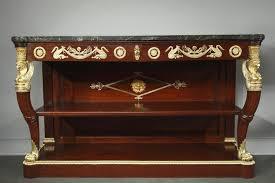
Bonaparte's own stepson, the future Prince Eugene, former member of the expedition, had his Parisian hotel in the rue de Lille overhauled [..] where the architect Bataille fits out an Egyptian-style portico and furnishes the apartments with an oriental boudoir decorated with a frieze representing a slave market and a harem. The rue de Sèvres is equipped with the famous Fellah fountain to distribute the waters of Gros-Caillou to the district. The English are not left out with the prestigious neo-Egyptian decorations created by Thomas Hoper in his London hotel on Duchess-Street or by Walsh Porter in his cottage in Craven. As for the pyramids, one now sees them in all the gardens (such as in Parc Monceau), but even more in the cemeteries, in Père-Lachaise mainly, under which several members of the expedition will be buried, the surgeon Dominique Larrey in particular. [..]
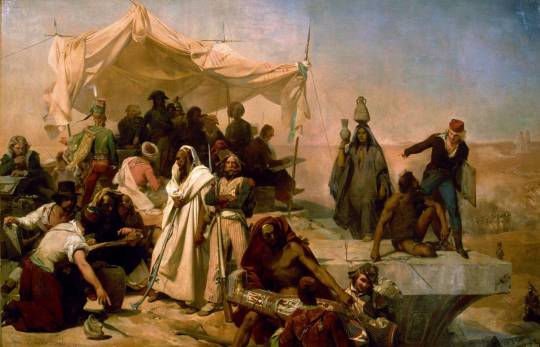
[Léon Cogniet (1794-1880)- L'expédition d'Egypte sous les ordres de Bonaparte.]
Even today, several streets in Paris evoke the expedition, such as the streets of Aboukir, Cairo or Heliopolis. And throughout the 19th century, the memory of the expedition made it possible to establish between France and Egypt privileged relations which reached their peak under the reign of Charles X [..] The expedition, again, provided painters the revelation of azure skies and golden light which, with Gros, Lancret, Chabrol, Lejeune, and later Delacroix, gave birth to the orientalist current expressed throughout the 19th century until the Third Republic. Egypt, of course, also inspired writers and travelers of the romantic era, such as Alexandre Dumas with his Voyage au Sinaï, Théophile Gautier with the Roman de la momie, Alfred de Vigny with the Plainte du Capitaine, but also Chateaubriand, Balzac, Flaubert, Nerval and Hugo, all fascinated by this real or imagined country.
Gonzague Saint-Bris- Desaix, le sultan de Bonaparte
#napoleonic#gonzague saint bris#desaix le sultan de bonaparte#retour d'égypte#arts and crafts#campaign of egypt
17 notes
·
View notes
Photo
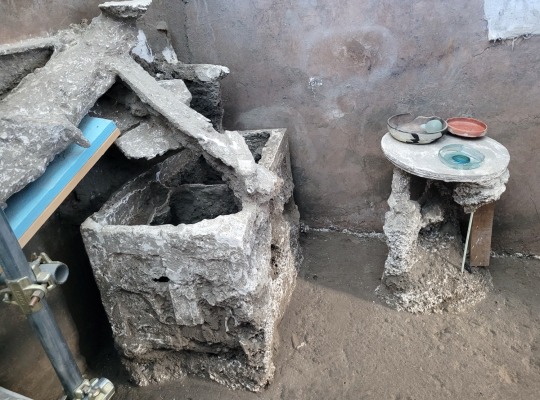
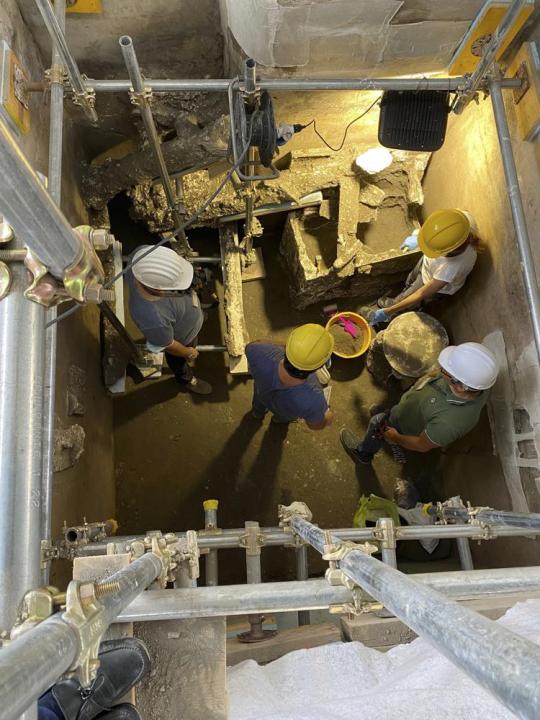

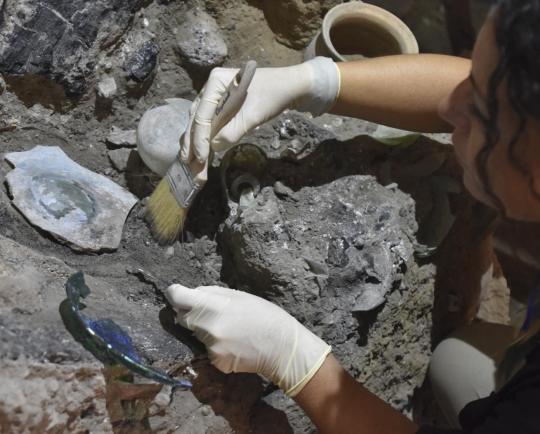
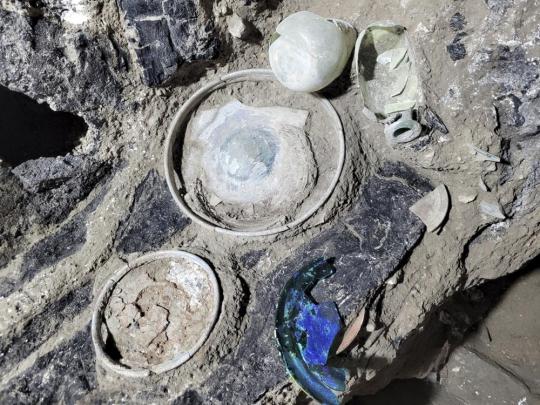
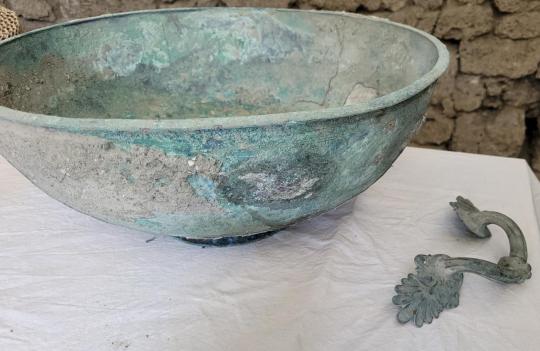

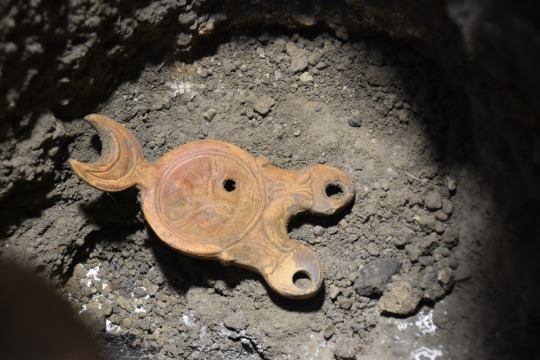

Discoveries in Pompeii Reveal Lives of Lower and Middle Classes
The latest discoveries in the excavation of Pompeii’s Regio V neighborhood are fully furnished utility spaces, of great archaeological significance for the details they preserve of a common domestic context in the 1st century Roman town.
The room was found in the House of the Enchanted Garden, a beautifully frescoed home with a lararium (a shrine to the household gods) that is one of the largest ever discovered in Pompeii. In 2021, archaeologists undertook an excavation and restoration of rooms on the ground floor in front of the lararium and the stories above it. They uncovered four rooms, two on the ground floor and two above, that were furnished. One was unfinished, with unplastered walls and an earthen floor, a jarring contrast in a house so decorated with such fine frescoes. The unfinished room was used for storage.
Archaeologists were able to make casts of the furnishings in the room which left a cavity in the hardened ash that could be filled with plaster. One room contained a bed frame and a pillow. The texture of the fabric was imprinted in the ash and is visible on the plaster cast. It is a very simple cot with ropes strung across the sides. There isn’t even a mattress, let along any decoration. Next to the bed was a wooden trunk divided into two compartments. The lid was open, but broken when the beams and floorboards of the story above collapsed in the eruption. Inside the trunk, archaeologists found a terra sigillata saucer and a double-spouted oil lamp depicting Zeus in the act of transforming into an eagle. Next to the trunk was a circular three-legged table with a shallow ceramic bowl containing two small glass bottles, a blue glass saucer and a terra sigillata bowl.
In the storage room, archaeologists were able to make two casts: a shelf and a group of wooden planks in different sizes, cuts and finishes, tied together. This was probably a collection of raw materials for assorted home maintenance projects from furniture patching to roof repair. Outside the room in a small hallway another utilitarian treasure was found: a tall wooden cabinet with at least four doors and five internal shelves. The top of the wardrobe and the front doors were damaged when the floor above the room collapsed. The remains of jugs, amphorae, bowls and plates were found on the damaged top shelf.
The excavation of the upper rooms revealed materials that were in the process of collapsing onto the rooms below. Of enormous archaeological value is a unique group of wax writing tablets. The group consists of seven triptychs tied both vertically and horizontally by a cord. A large cupboard, collapsed in the eruption, was also excavated. It contained different types of common use ceramics for kitchen and dining, as well as fine terra sigillata ceramics and glass. There was also a set of small bronze vessels, including a basin with palm leaf-shaped handles and a small jug decorated with a sphinx and lion’s head. Another special treasure is an incense burner shaped like a cradle with a male figure at one end. The polychrome paint coloring the figure and decorating the cradle with geometric designs is perfectly preserved.
The excavation overlapped onto a residential property behind the House of the Enchanted Garden, and there the plaster cast technique revealed the imprint of cane lathing in the mortar of a collapsed false ceiling. The cast shows the guts of Pompeiian construction: bundles of caning tied together by a thin cord and covered by a gauze-like fabric to separate the lathing from the wet mortar. Casts were also obtained of what appears to be wood paneling on the north, east and south walls of the room. Some are carved with coffered decoration; others are inlaid with delicate bone elements.
#Discoveries in Pompeii Reveal Lives of Lower and Middle Classes#House of the Enchanted Garden#archeology#archeolgst#ancient artifacts#history#history news#ancient history#ancient culture#ancient civilizations#roman empire#roman history
75 notes
·
View notes
Text
Archaeological Adventures in Egypt
Hello! I am Dr. Lisa Saladino Haney, Assistant Curator at Carnegie Museum of Natural History and resident Egyptologist. An Egyptologist is someone who studies the history, material culture, architecture, religion, and writing of the ancient Egyptians – one of the ancient cultural groups living in Africa’s Nile Valley. Learning about ancient cultures helps us to better understand the world today and to appreciate the creativity and ingenuity of people who lived thousands of years ago. Archaeology is one technique that allows us to interact with and study the past and there are hundreds of archaeological sites and projects throughout the Nile Valley that constantly add to our understanding of what life was like.
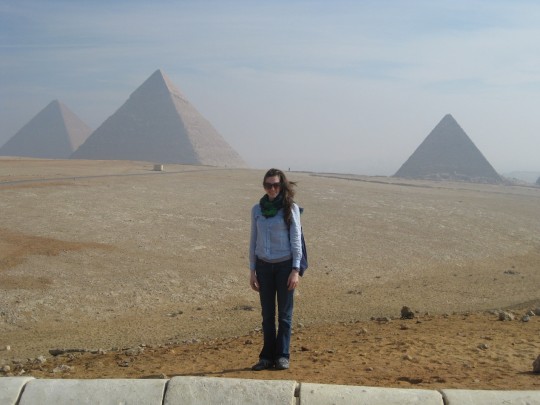
Trying to determine some of my favorite archaeological sites from my travels in Egypt turned out to be an impossible task! Please join me on this photo exploration of a few of the many interesting archaeological sites in Egypt and learn where you can find more information about active archaeological excavations and other projects going on in those areas.
Saqqara
Saqqara is an important cemetery site associated with the ancient Egyptian capital city of Memphis, near modern Cairo. The cemeteries at Saqqara contain a number of tombs, both royal and private, including the famous Step Pyramid of the Third Dynasty Egyptian king, Djoser (ca. 2630-2611 BCE). The earliest burials at the site date to the creation of the ancient Egyptian state and it remained an important site through the Graeco-Roman Period.
Royal Tombs: The Step Pyramid of Djoser
The Step Pyramid of Djoser marks an important step in the development of the pyramid-shaped royal tomb. The complex was designed by the famous royal architect Imhotep, who would later become deified in ancient Egypt. You can see a bronze statue of Imhotep in Walton Hall of Ancient Egypt. A 14-year long restoration project at the site was just completed in 2020 which included strengthening the overall integrity of the structure by filling in gaps in its six rectangular mastabas as well work on the interior burial chamber and passages of the pyramid.
Check out some pictures from my visit to the Step Pyramid in 2011, early on in the restoration process, or, for a gallery of photos and more on the newly completed restoration, click here.

Views of the Step Pyramid at Saqqara showing the scaffolding used for the restoration project (photos by author).
Old Kingdom Mastabas: Tombs of Kagemni and Niankhkhnum and Khnumhotep
The Old Kingdom (ca. 2649-2150 BCE) mastabas at Saqqara are some of the most beautifully preserved and decorated tombs. Here are two of my favorites from my last visit. The tomb of Kagemni is the largest mastaba in the cemetery associated with the reign of the Sixth Dynasty king Teti (ca. 2323-2150 BCE). Kagemni was a Vizier, the highest position in the royal administration.

The tomb of Niankhkhnum and Khnumhoptep, also known as the tomb of the two brothers, dates to the late Fifth Dynasty and contains a number of exceptional scenes that underscore the closeness of the two men, both of whom served as overseers of the royal manicurists. Archaeologists uncovered a number of blocks from the tomb’s entrance repurposed in the nearby causeway of the pyramid complex of the late Fifth Dynasty king Unas (ca. 2353-2323 BCE). Thanks to the Egyptian Ministry of Tourism and Antiquities, you can now go on a virtual tour of the tomb!

Here you see the names of the two tomb owners, Niankhkhnum and Khnumhotep on a stone doorway inside their tomb as well the exterior of the mastaba (photos by author).

Scenes depicting Niankhkhnum and Khnumhotep inside their tomb (photos by author).

Images from the Tomb of Kagemni at Saqqara depicting the tomb owner himself, a parade of offering bearers bringing animals, plants, food, and other supplies to the deceased, and a scene taking place on the Nile where we get an underwater view of a crocodile eating a fish (photos by author).
Beni Hasan
Beni Hasan is a cemetery site located in Middle Egypt, near the modern city of Minya, that was important during Egypt’s Middle Kingdom (ca. 2030-1640 BCE). During that time some of the most elite Egyptians were buried on the escarpment (desert cliff) with one of the most beautiful views of Nile Valley around! For more on excavations at Beni Hasan in the early 1900s visit the Griffith Institute and for a virtual tour of the tomb of Kheti at Beni Hasan visit the Egyptian Ministry of Tourism and Antiquities.

Top: A row of tomb entrances in the cliff face at Beni Hasan (photo by author). Middle: Image of the Nomarch Khnumhotep II fishing and fowling in his tomb (photo by author). Bottom: View of the Nile Valley from the tombs at Beni Hasan (photo by author).
Karnak
Karnak temple complex is one of the largest religious sites in the world. The first temple at the site was built during the Middle Kingdom (ca. 2030-1640 BCE) and the complex grew in size and complexity over time. The main temple at Karnak is dedicated to the Egyptian god Amun-Re, but there are smaller temples dedicated to Mut, Khonsu, and others. See if you can spot the snoozing pups in the pics below!
There are a number of ongoing excavations at Karnak that you can explore to learn more about the site. Check out this amazing minicourse on the Karnak Mut Precinct available on YouTube with Dr. Betsy Bryan, Alexander Badawy Chair of Egyptian Art and Archaeology and Director of Johns Hopkins’ excavations at the Mut Precinct.
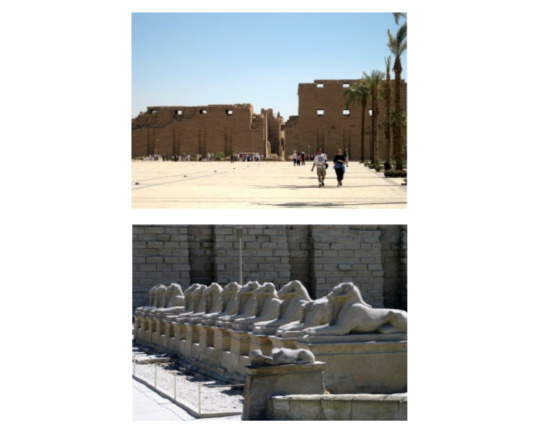
Approach to Karnak Temple and processional way lined with Ram-headed sphinxes for the god Amun-Re (photos by author).

Sleepy Karnak pups (photos by author).

Inside Karnak Temple: Festival Hall of Thutmose III, Obelisks, exit towards the Sacred Lake, columns in the Hypostyle Hall (photos by author).
Lisa Saladino Haney is Postdoctoral Assistant Curator of Egypt on the Nile at Carnegie Museum of Natural History. Museum employees are encouraged to blog about their unique experiences and knowledge gained from working at the museum.
17 notes
·
View notes
Note
Don’t care. Didn’t ask. Plus you’re fat.
The earliest known form of Greek chair dates back to six or seven centuries BCE. On the frieze of the Parthenon, Zeus occupies a square seat with a bar-back and thick turned legs; it is ornamented with winged sphinxes and the feet of beasts. The characteristic Roman chairs were of marble, also adorned with sphinxes. The curule chair was originally very similar in form to the modern folding chair, but eventually received a good deal of ornament. The most famous of the very few chairs which have come down from a remote antiquity is the reputed Chair of Saint Peter in St Peter's Basilica at Rome. The wooden portions are much decayed, but it would appear to be Byzantine work of the 6th century, and to be really an ancient sedia gestatoria. It has ivory carvings representing the labours of Hercules. A few pieces of an earlier oaken chair have been let in; the existing one, Gregorovius says, is of acacia wood. The legend that this was the curile chair of the senator Pudens is necessarily apocryphal. It is not, as is popularly supposed, enclosed in Gian Lorenzo Bernini's bronze chair, but is kept under triple lock and exhibited only once in a century. Byzantium, like Greece and Rome, affected the curule form of chair, and in addition to lions’ heads and winged figures of Victory (or Nike) and dolphin-shaped arms used also the lyre-back which has been made familiar by the pseudo-classical revival of the end of the 18th century.
26 notes
·
View notes
Text
What to visit in Egypt Tours
Bahariya oasis safari trip with ((Oasis Egypt Safari company )) From guided group tours and tailor-made holidays to fun family adventures and trips crafted for solo travelers It will find the true meaning of fun.
Most tourists to Egypt have a long checklist of sights they want to see Egypt Tours as White Desert Egypt, The Great Pyramid of Giza, the Sphinx,
where you will be able to explore rather and live Adventure and relaxing.
Trips with Oasis Egypt Safari group
The Whales Valley, Crystal Mountain, Bedouin village, Fayoum Oasis, Temples, Bahariya, Siwa, the Egyptian Museum. to name a few.
White Desert Egypt best escape anyone can have, Company Oasis Egypt Safari offers Tours Package to Bahariya oasis.
This trip designed for those who like Adventure to set in the center of Desert Egypt.
with us Company Oasis Egypt Safari you will reconnoiter The magic of nature.
paradise of Desert Egypt
where you will be able to relax in the paradise of Safari Desert Egypt at night where A sky full of stars and music,
enjoyment natural bliss charm. has located 45 km (28 mi) north of the town of Farafra.
A fantastic gleaming landscape in western Egypt.
located stretches over 300 sq.km west of the Farafra Oasis between the Nile Delta Valley and the Libyan border.
safaris with Oasis Egypt Safari is rightly stunning because we have a lot of discoveries.
The White desert Arriving there is like a stepping instance, a different planet When you are in the desert.
you are entirely disconnected from everything that shatters the quiet of your life today, safari with Oasis Egypt Safari is rightly different.
The desert has a white, cream color rather and in the shapes of volcanoes, black colored. a natural museum of chalk rock sculptures.
an inspiring natural sanctuary far from the hubbub.
comprise beautiful forms — dome, minarets, castles, rabbits, and turtles.
TRIP TO BAHARIYA OASIS VISIT BLACK AND WHITE DESERT FROM CAIRO:
Day 1
After arriving at The Bahariya oasis start to going to the black desert and going to the Bedouin village.
we will have our lunch in the cold spring. after that, we going to Crystal mountain it’s This is good appropriateness.
while start Egypt tours by the first stop in crystal mountain after seeing the crystal stone.
and the beautiful aria going to see one of the best places in the national park (al agbat ).first established as a protected area in 2002.
from Cairo at 6:00 am arrive at Bahariya oasis at 10:00 am chang the normal car and take the land crouse 4×4.
Oasis Egypt safari package
Oasis Egypt safari organizes Safaris The package to the desert includes safari tours, food, drink, and camping accommodation.
Day 2
Enjoy trip See the sunrise and take breakfast rather and going to see chicken rather and mushroom rook then going to the hot spring, then, back to Bahariya oasis and Cairo.
Will you enjoy life-changing experiences Therefore, you will do so with the bestead value for your money. now Explore the good and new Life.
just let your fiction go, as wild as it can and go to safaris with the Oasis Egypt Safari.
Then, going back to Bedouin village rather and have lunch in cold spring than going back to stop in the black desert the back to Bahariya oasis.
BOOK ONLINE NOW IN EGYPT DAY TOURS
Oasis Egypt Safari one of the top in Egypt companies will take you to another world for you reconnoiter the various amazing sites certainly Egypt and desert Egypt.
TRIP OVERVIEW AT TEMPLES AND MONASTERIES IN WESTERN DESERT:-
The desert national park the magical place starts with mushroom rook information chicken and camel and rabbit.
a mudbrick structure measuring about 30m by 20m In the western desert.
In Roman at the western desert, a small protector of troops would have guarded the fortress.
What is a palace Qasr Dush
Surrounding the hill of Qasr Dush is the site of the ancient town of lysis, one of the oldest Roman ruins in Kharga Oasis.
Safari White desert
by French archaeologists of the IFAO who have found evidence of temporary occupation possibly dating back as early as the Old Kingdom (possibly Dynasty IV).
Abutting the Roman fortress on the eastern side is the residue of a sandstone temple, enlarged by Trajan.
Desert Egypt Safari Trip
A monumental stone gateway fronts the temple in the western desert and contains a dedicatory inscription.
In the way, by Trajan dated AD 116, graffiti by Caillaud and other nineteenth-century travelers.
To the north is a large forecourt containing five columns with its northern end.
The main part of the temple measures approximately 7.5m by 15.5m and contains a pillared hall with four slender columns.
White Desert Tour|Oasis Egypt Safari:
This is the best in the western desert, staircase to the roof, and offering table in an outer chamber and an inner sanctuary with a vaulted roof.
Oasis Safari Egypt. discover The western desert is a beautiful area
March 1989 at the western desert, French archaeologists discovered a majestic collecting from artifacts, now known as the Qasr Dush
uncovered a linen-wrapped gilt statuette of Isis a small bronze figure of Horus dressed as a Roman legionary and a bronze figure of Osiris.
BOOK ONLINE NOW IN EGYPT DAY TOURS
Get all- everything inclusive safaris to Egypt Safari
Return to Hot Tours
Return to 3 Day Tours
1 note
·
View note
Text
Vatican Museums (Musei Vaticani)
The entrance is in Viale Vaticano near Piazza Risorgimento. There is also a regular free bus service from Piazza S.Pietro (on the left of Bernini's Colonnades as you face the Basilica).
The Vatican houses one of the world's great art collections. Its 7km of exhibits will daunt even the most energetic tourist. So if you only have limited time plan to take in what interests you most - and hurry past the rest.
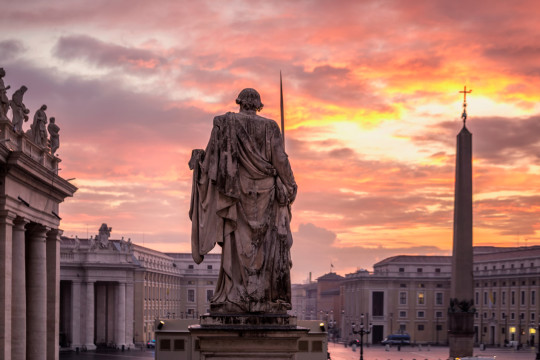
A oneway system operates for security reasons, so work out in advance what you wish to miss - you cannot go back for example to the Stanze di Rafaello after visiting the Capella Sistina (Sistine Chapel). Remember also that the Sistine chapel is a long walk - about 400m from the entrance along many corridors and staircases.

Popes have been collecting antique art for at least 500 years and today the Vatican contains the largest number of Greek and Roman statues, reliefs, mosaics and inscriptions of any museum in the world.
The Museo Pio Clementino takes its name from two 18th-century Popes who tried to put some order among the large number of pieces of classical statuary littering the Vatican gardens and palaces.
Note the splendid 4th-century porphyry sarcophagi in the Sala a Croce Greca (hall in the shape of a Greek cross), also a sculpted head (no. 567) that is most likely a portrait of Cleopatra.
In the octagonal courtyard of the Belvedere Palace, which was the creation of one of the main founders of the Vatican collection, Pope Julius II, you can see one of the most famous sculptures of ancient Greece, the Laocoon, a marble group of the 2nd century bc dug up on the Esquiline hill in 1506 (from Domus Aurea). Laocoon, a priest of Apollo, and his sons were suffocated by serpents as a punishment by the gods. Opposite is the Apollo del Belvedere a fine Roman copy of a famous 4th-century bc Greek bronze.

Nearby in the Atrio del Torso is the famous Torso del Belvedere a fragment of a naked figure seated on the skin of a wild animal. The hidden power in this much damaged piece of marble is reputed to have impressed even Michelangelo.
The Braccio Nuovo (New Wing) a 19th-century addition, contains a telling portrait of Augustus (No. 14) at about the age of 40, and a colossal statue of the Nile river god surrounded by sphinxes and crocodiles.
You now penetrate into part of the Vatican Library. In the Sala Sistina is a strange wooden device which was used to fix the Papal seal or 'bollo' on important Papal documents or 'Bulls' as they were called in English. The central reading room is laid out with various valuable codices, or handwritten versions of the Bible, some written on papyrus.
The Library contains over 70,000 codices, manuscripts and early printed books. On display are a set of love letters from King Henry VIII to Ann Boleyn (evidence used against the sovereign in excommunication proceedings), an illustrated book on falconry by the Holy Roman Emperor Frederick II, and autograph letters of Michelangelo and Raphael.
The Capella Sistina (now undergoing its first major cleaning and restoration) is perhaps the most famous and overwhelming of all Rome's art treasures. The chapel, built by Pope Sixtus IV at the end of the 15th century, was decorated by some of the greatest artists of the day, including Botticelli, Signorelli, and Pinturicchio. But it was Michelangelo's painting of the huge ceiling between 1508 and 1512 and his masterpiece, the LastJudgement painted on the main altar wall 23 years later that set the seal of greatness on the building.

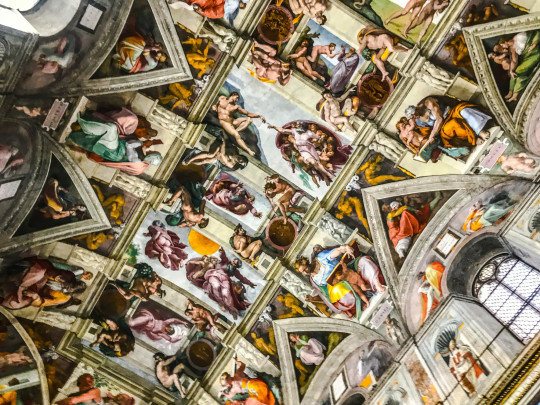
Michelangelo was at first reluctant to carry out Pope Julius I’s commission to paint the events of the Creation, and had great difficulty in getting paid for his tour deforce. Refusing all assistance, he locked himself away for years, lying on his back suspended from scaffolding in order to paint over 3000sq m 10,000sq ft of ceiling. It is a feat that still takes away the breath of the visitors who pass through the chapel every day.
If the Creation breathes the very spirit of the Renaissance at its height, the Last Judgement is in very different mood. Terribilitd (terribleness) was the quality in Michelangelo's art that most impressed his contemporaries, and here with Christ standing in final judgement over humanity (including many actual portrait's of the artist's friends and enemies), you feel Michelangelo is making his final statement on life and death, honour and ambition, love and hate.
The Last Judgement did not meet with universal approval. Prudish Popes ordered trousers or loin cloths to be painted on some of the nudes. (They were later removed.) The Sistine Chapel is today used for the election of a new Pope on the death of the Roman Pontiff, and for solemn assemblies of the College of Cardinals.
While Michelangelo was labouring alone on his great ceiling, his rival and fellow artist Raphael was working (with plenty of assistants) on the decoration of the nearby Stanze di Rafaello. (Raphael Rooms). This was the private apartment of Pope Julius II who did not want to live in the Borgia Apartment below, because of its unpleasant historical associations. Two of the rooms, the Stanza della Segnatura, the Pope's study and library, and the Stanza di Eliodoro, his bedroom, are mostly by Raphael's own hand.
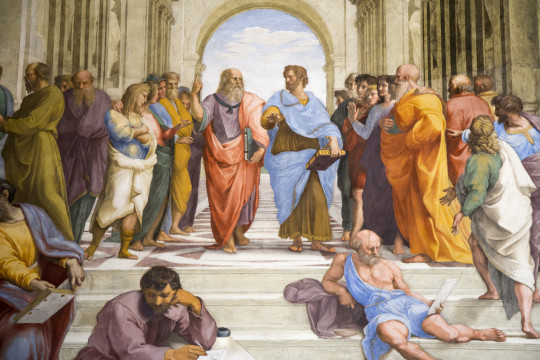
Truth, beauty and goodness are the subjects of the frescoes in the first room. The Disputation of the Sacrament and the School of Athens represent respectively religious and philosophical truth, while Apollo and the Muses on Mount Parnassus represent beauty. Goodness is portrayed by the cardinal virtues, prudence, temperance and strength. The second room contains three superb frescoes; the Expulsion of Heliodorusfrom the Temple in Jerusalem, Pope Leo Stopping the Invasion of Attila the Hun, and the Miracle of Bolsena.
The Museo Gregoriano Etrusco should not be missed as it -contains the Etruscan treasure discovered in 1837 in a tomb at Cerveteri (then part of the Pope's earthly domain).
The three occupants of the tomb were buried with gold, silver, jewels, and richly decorated table ware. The Museo Profano and the Museo Cristiano (Profane and Christian Museums) used to be housed in the Lateran Palace and were transferred here into a new building in 1970.
They contain Roman sculpture, inscriptions and sarcophagi dating from the lst-4th centuries ad. The 4th-century statue of the Good Shepherd is an excellent example of the continuity of Mediterranean art forms - the inspiration is clearly pagan and ancient Greek.
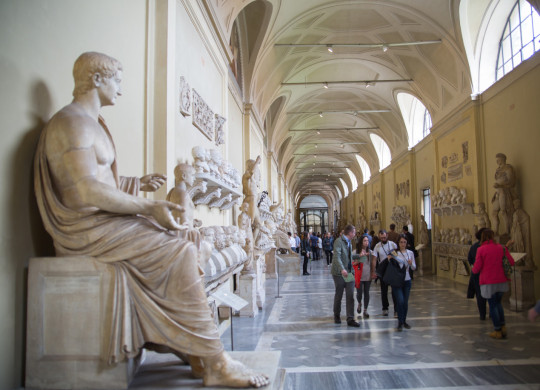
If you are not too exhausted, the Pinacoteca or Vatican Picture Gallery contains further riches. It is particularly well endowed with Primitives and 15th century Italian artists.
The Giotto polyptych in Room II and the Melozzo da Forli Angels in Room IV are worth more than a passing glance. In Room VIII there is a Raphael feast. The Transfiguration, Raphael's last work (it was hung above his bier as he lay in state) has been cleaned recently, revealing unexpected new details. Also on view is a set of tapestries woven from Raphael's cartoons for the Capella Sistina, now in the Victoria and Albert Museum in London. The Coronation of the Virgin was the first work of Raphael's maturity - he was 20 years old when he painted it.
#vatican museums#vatican#italy#rome#roma#travel#vatican city#popes#sistine chapel#pinacoteca#vatican picture gallery#capella sistina
80 notes
·
View notes